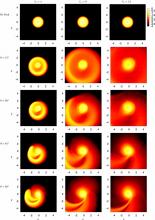
Abstract
Numerical calculations of merging black hole binaries indicate that asymmetric emission of gravitational radiation can kick the merged black hole at up to thousands of km/s, and a number of systems have been observed recently whose properties are consistent with an active galactic nucleus containing a supermassive black hole moving with substantial velocity with respect to its broader accretion disk. We study here the effect of an impulsive kick delivered to a black hole on the dynamical evolution of its accretion disk using a smoothed particle hydrodynamics code, focusing attention on the role played by the kick angle with respect to the orbital angular momentum vector of the pre-kicked disk. We find that for more vertical kicks, for which the angle between the kick and the normal vector to the disk $\theta\lesssim 30^\circ$, a gap remains present in the inner disk, in accordance with the prediction from an analytic collisionless Keplerian disk model, while for more oblique kicks with $\theta\gtrsim 45^\circ$, matter rapidly accretes toward the black hole. There is a systematic trend for higher potential luminosities for more oblique kick angles for a given black hole mass, disk mass and kick velocity, and we find large amplitude oscillations in time in the case of a kick oriented $60^\circ$ from the vertical.